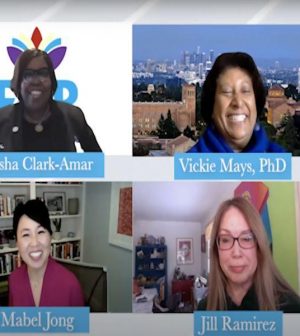- Navigating Your Midlife Crisis: Embracing New Possibilities
- City Raccoons Showing Signs of Domestication
- Mapping the Exposome: Science Broadens Focus to Environmental Disease Triggers
- One Week Less on Social Media Linked to Better Mental Health
- Your Brain Changes in Stages as You Age, Study Finds
- Some Suicide Victims Show No Typical Warning Signs, Study Finds
- ByHeart Formula Faces Lawsuits After Babies Sickened With Botulism
- Switch to Vegan Diet Could Cut Your Greenhouse Gas Emissions in Half
- Regular Bedtime Does Wonders for Blood Pressure
- Dining Alone Could Mean Worse Nutrition for Seniors
Mental Health ‘Epidemic’ Threatens Communities of Color Amid COVID-19

Communities of color face a burgeoning wave of mental health problems as a result of how the COVID-19 pandemic has changed the way people interact and grieve, experts warn.
“We’re about to have a mental health epidemic because of COVID,” Vickie Mays, a professor of health policy and director of the UCLA Center on Research, Education, Training and Strategic Communication on Minority Health Disparities, said during an HDLive! interview.
Mays said mood disorders, substance abuse and suicides are increasing in racial and ethnic communities in the United States, driven in part by the social isolation required to prevent spread of the coronavirus.
“Think about what it’s like to be Black or Latinx, lose somebody in your family, and you can’t provide the going home celebration for them. That’s a hurt and a grief that people don’t get over,” Mays said. “To know that your mom did all that she could and here you have to do this online stuff, where her friends can’t be there with her and comfort her children, this is leaving some very deep grief and wounds in people that we need to address soon.”
Tasha Clark-Amar, CEO of the East Baton Rouge Council on Aging, said in the same interview that Louisiana families are no longer able to come together after a funeral to commune at a dinner “where you get together and you say your goodbyes.
“Those have been cut out and it’s been detrimental to the community, for sure,” Clark-Amar said.
Urban communities are particularly susceptible to a resurgence in mood disorders and substance abuse, given that they’ve been subject to some of the worst waves of COVID-19 cases in the nation, said Dr. Allison Navis. She’s a mental health specialist and director of the neurology clinic at the Icahn School of Medicine at Mount Sinai in New York City.
“A lot of our patients who were sick in March or April, even if they had a milder infection, it was a very scary time here in the city,” Navis said. “They might have been alone in their apartments and the hospitals being overwhelmed and hearing ambulances outside and so a lot of patients were really quite fearful understandably about whether they would survive this. That has absolutely affected them and caused depression or anxiety or PTSD.”
Separation distress, dysfunctional grief and post-traumatic stress are also interfering with the daily lives of many Americans who lost a loved one to COVID, according to a study published recently in the Journal of Pain and Symptom Management.
“Existing research shows that grief from deaths during the pandemic was felt more acutely than that following both deaths before the pandemic and deaths from other natural causes,” study author Lauren Breen, an associate professor at Curtin University in Perth, Australia, said in a university news release.
“This exacerbation of grief is due to the necessary restrictions that affect people’s access to dying loved ones, limit their participation in important rituals like funerals, and reduce the physical social support they would otherwise receive from friends and family,” Breen explained.
Grieving people need to receive better support even prior to the death of their friends and relatives, while the sick are under palliative care, Breen said. In particular, the United States needs more grief counselors to help people deal with their loss.
Mays expects it will be down to social organizations in various communities to provide the bulk of the help people will need as a result of the pandemic.
“This reminds of when I worked in New Orleans for [Hurricane] Katrina,” Mays said. “It is going to be the community agencies that are going to have to engage in community rituals and processes where they put up support mechanisms for people to check in.”
In one example, organizers in Austin, Texas, asked an artist to create a community mural to commemorate those who’d died from COVID, said Jill Ramirez, executive director for the Latino HealthCare Forum in Austin.
“At that time, we had close to 300 people had passed. We put the number on the mural, how many people had died, and we invited the community to come and do a vigil,” Ramirez said.
“I think we need to do more of those kind of things so we can really help people grieve,” Ramirez said. “Right now, I think people are just trying to take care of themselves the best they can.”
More information
The U.S. Centers for Disease Control and Prevention has more about dealing with grief and loss during the pandemic.
SOURCES: Tasha Clark-Amar, CEO, East Baton Rouge Council on Aging, Louisiana; Jill Ramirez, executive director, Latino HealthCare Forum, Austin, Texas; Vickie Mays, PhD, professor, health policy, and director, UCLA Center on Research, Education, Training and Strategic Communication on Minority Health Disparities, Los Angeles; Allison Navis, MD, neurology clinic director, Icahn School of Medicine at Mount Sinai, New York City; Curtin University, news release, Feb. 25, 2021
Source: HealthDay
Copyright © 2025 HealthDay. All rights reserved.










